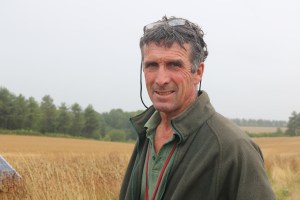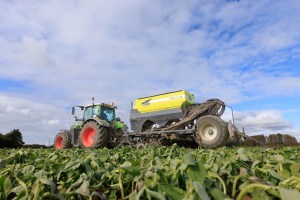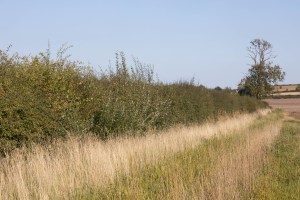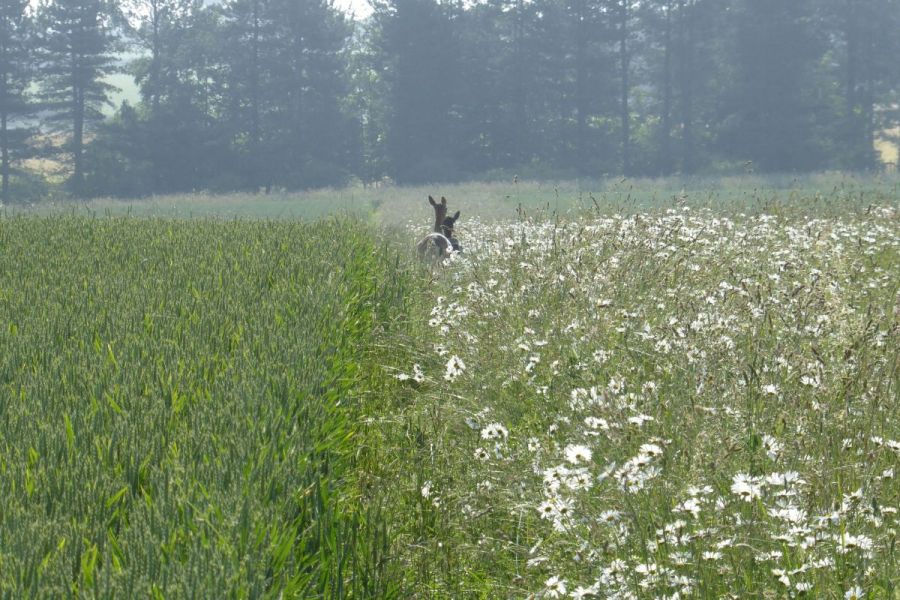Scientists, farmers and industry came together recently at an Association of Applied Biologists (AAB) conference to discuss the challenges and opportunities regenerative practices may offer. CPM was there.
“Regenerative agricultural practices designed to maximise soil health have a positive knock-on effect on crop pests and their natural enemies.”
By Emily Padfield
Bring together all parties with a keen interest in regenerative farming and it’s no surprise that soils held centre stage at the recent Association of Applied Biologists conference in York.
For Syngenta’s Sean Jellesmark and Edna Roedig, it’s a case of measure to manage to measure. They told delegates that quantifying soil health and the impact of management decisions is crucial in order to measure progress towards sustainable land management. And with this in mind, they’ve been working on a systematic approach to quantifying soil quality on a European-wide level.

Soil improvements on the 800ha Hendred Estate are mostly down to effectively harnessing the miracle that is photosynthesis, according to Julian Gold.
The test is based on eight soil properties and uses the site-based Muench Enberg Soil Quality Rating method. Challenges to measuring soil health on a wide scale are mostly down to there being no single defined framework for soil health, the pair explained.
“Soil health is not a uniform measure and sampling soil health indicators large-scale is extremely resource intensive. The aim has been to develop a simple approach for stakeholders to assess soil health anywhere in Europe in order to estimate the impact of different management practices and to, in turn, track progress towards achieving healthy soils.”
The method includes a number of soil characteristics such as texture, humus, stricture, subsoil compaction and several others which are given a numerical value following scoring tables, after which spatial weights are assigned according to climatic regions. Conservation agriculture practices are then overlayed on these basic indicators to give a value, while validation can be achieved overlaying yield results and soil quality scores.
Initial research suggests using conservation agricultural practices show an average improvement of 15% on a European-wide soil health metric, which gives policy makers and growers crucial insight into the efficacy of different management methods on a pan-European level, leading to more future-proof policy making in the future.
Harnessing photosynthesis
Soil improvements measured over the past 20 years on the 800ha Hendred Estate are mostly down to effectively harnessing the miracle that is photosynthesis, according to farm manager Julian Gold.
“I really see myself not as a farmer but as a photosynthesis facilitator,” he joked. “I am an employee of the soil ecosystem and am allowed to take grains as my wage. The soil ecosystem is the engine of the planet and carbon is the fuel to keep this engine running.”
By growing high yielding crops, Julian believes he’s maximising carbon sequestration in soil via photosynthesis. All crop residue is returned to the soil and cultivations are kept to an absolute minimum through practices such as direct drilling, little or no cultivation and 10m controlled traffic farming methods.
“Once carbon is sequestered into the soil every effort is made to ensure it isn’t re-oxidised through soil disturbance. To maximise photosynthesis we need to be utilising all the sunshine we can, which doesn’t always coincide with when we have a crop in the ground due to harvesting.
“It’s crucial to get cover crops big enough, early enough to capture this all-important sunlight. We try to chase the combine out of the field with the drill wherever possible.”
Julian has found that following yields are better when terminating cover crops in a frost with a roller as opposed to with sheep, but he acknowledged this isn’t always possible. Always at the back of his mind is the fine balance which exists when using inorganic N. While he acknowledged a level of N is important to increase biomass, photosynthetic rate and yield, he recognised the damage that can be caused through leaching, gaseous losses and degradation of soil organic matter.
“Lots more research has to be done to arrive at ‘environmentally optimum’ N rates to replace the more conventional ‘economically optimum’ rates that currently exist. This idea forms my sixth regenerative agriculture principle: Minimising synthetic N use.”
Converting NOx to feed plants
A large proportion of agriculture’s greenhouse gas emissions (GHG) can be put down to nitrogen-based fertilisers, which cause NOx air pollution due to nitrous oxide (N20) being released when nitrates are drawn down. NOx is a dangerous greenhouse gas with a global warming potential 265 times that of CO2.
R-Leaf is described as a disruptive technology that captures atmospheric NOx pollutants (N20, NO and NO2) and converts them instead into plant feed.
It’s made up of photocatalysts that have been processed to enable NOx catalysis under normal day light conditions, explained Dr Apostolos Papadopoulos of Crop Intellect. “Sunlight charges the photocatalytic surface and when NOx comes into contact, the molecules break down to inert material and nitrate. The nitrate is solubilised with dew and rain and taken up by the plant surface, resulting in increased biomass and yield.
“When these photocatalysts – based on food ingredients – are charged with daylight, electrons and holes (h+) are produced. The negatively charged electrons capture oxygen from the air and produce superoxide anions, leading to holes (h+) capturing water molecules from the air to produce hydroxyl (OH) radicals. In contact with NOx, they react and break it down into nitrate, water and CO2, all of which are essential for crop growth.”
R-Leaf can be sprayed onto any crop, is a stable suspension concentrate and can be tank-mixed with most agrochemical inputs.
“It contains 500g of a processed photocatalytic material and is classed as an EC fertiliser containing zinc, molybdenum and manganese, which are often deficient in crops,” added Apostolos.
The recommended dosage of the product is 1.0 l/ha, with the best application timing for cereals during T1 and T2 – when the soil-applied nitrogen is starting to produce NOx and when the foliage is adequate to hold the solution.
In addition to crop benefits, the removal of N2O from the atmosphere using R-Leaf bears carbon credits, with 5.4t CO2 per year being removed from the atmosphere when using 2.0 l/ha during the spring, validated by the Climate Impact Forecast tool, he added.
On-farm measurement of GHG
In line with Defra’s Environmental Land Management scheme, it’s expected that farmers wishing to gain financial incentives in the future will have to deliver public goods, including a degree of climate change mitigation.
In order to do this, producers will need advanced technologies and management systems to minimise their own emissions. An Innovate UK funded collaboration between Newcastle University, Anglia Ruskin University and gas measurement manufacturer Mirico is currently testing a novel solution for measuring greenhouse gas emissions in the UK farming sector.
The technology makes use of Mirico’s Orion open path system, which uses lasers and mirrors to provide path averaged concentration of gases. Algorithms then deliver information on emissions rates and localise emissions sources to show changes over time. The device can survey an area of 1km2 and works in all weather conditions due to laser dispersion spectroscopy.
There are two phases to the project, explained Dr Sophie Purser. ‘Phase 1 is to measure methane emissions from grazing and Phase 2 to measure nitrous oxide emissions from biowaste applications.”
One of the first projects to use the sensor looks at different grazing practices and what differences there are when mob-grazing cattle as opposed to more conventional rotational grazing practices.
“This exciting new technology will enable on-farm research into strategies to reduce the carbon footprint of farming and deliver real-time decision making,” she commented.
Future for ULV spraying
Conventionally, chemical applications in agriculture involve using a product designed to be mixed with volumes of upwards of 100 litres water/ha using mounted, trailed or self-propelled sprayers.

Initial research suggests using conservation agricultural practices show an average improvement of 15% on a European-wide soil health metric.
But many countries are now looking at ultra-low volume (ULV) spraying as a viable alternative, explained Emeritus Professor at Imperial College London, Graham Matthews. “Although the technology is nothing new, the FAO have been using it regularly to control desert locusts as far back as the 1950s, ULV spraying using rotary atomiser nozzles has never been widely accepted by the agrochemical industry.”
One of the main reasons for this is the increased cost of the chemical due to it being a concentrated solution often mixed with some sort of oil, historically this was diesel but research has recently carried out using vegetable oils.
“However, now it could prove pertinent to re-examine the technology,” he commented. “Drivers towards ULVs include increased productivity, improved application timings, better retention of deposits on crops, reduced overall use of pesticides and reduced, if any, water use.”
Challenges include having to reformulate active pesticides, the cost of the formulation with oil, need for registration and the requirement for more efficacy data.
“But, with factors such as rain, washing deposits of chemicals off the plant into soils and ultimately into rivers and watercourses, now could be the time to look at ULV spraying more seriously.”
Carabid mediated pest control
Historically, it’s been thought that carabid abundance in crop areas works on the premise of spill-over from the wider farm landscape, such as field margins or hedges. However, recent research carried out by applied entomologist Dr Kelly Jowett of Rothamsted suggests otherwise.
“Our research proposes this assumption may not be true for key species of significance for pest control and furthermore, infield interventions such as undersowing and reduced tillage have been shown to play an important role in boosting carabid populations within the crop.
“Carabid abundance and species richness differs greatly by margin type with grass margins affecting the spill over zone, and wildflower margins clearly lowering overall numbers within the crop.”

It’s been thought that carabid abundance in crop areas works on the premise of spill-over from the wider farm landscape, such as field margins or hedges. Recent research suggests otherwise.
In a bid to change the long-held perceptions that out-of-field interventions (such as wildflower margins) hold more weight than in-field regenerative practices when it comes to increasing carabid populations, Kelly has been actively involved in farmer self-monitoring and educational projects.
“This research has also looked at the barriers to uptake of integrated pest management on farm and how we can overcome them,” she said.
Monitoring includes farm and field-scale measuring using subterranean as well as pitfall traps and using resources such as identification guides for farmland carabids and simple guidance for on-farm testing and measuring.
“We have also looked at the social science aspects of farmer perceptions on implementation of infield practices and semi-natural area interventions towards enhanced carabid populations.”
Practices bring hope to OSR growers
“I like to refer to cabbage stem flea beetle as ‘two pests for the price of one’,” quipped Dr Samantha Cook at the start of her presentation on oilseed rape production. “Larval feeding weakens the plant and, in turn, increases susceptibility to disease, while adult feeding decimates crop establishment.”
This has led to the reduction in the UK OSR area by as much as 50% over the past 10 years. Pyrethroid resistance and the ban of neonicotinoid seed treatments are the main drivers of the collapse of the UK OSR crop, leading to the UK importing the crop from countries using less sustainable practices, she said.

According to Sam Cook, reduced tillage, soil cover and plant diversification practices positively impact pest pressure and pest regulation in OSR.
“And the truth is that OSR is a hugely environmentally beneficial crop to grow, supporting strong population of bees, butterflies and other pollinators, as well as invertebrates used as a food source for farmland birds.”
Regenerative agricultural practices adopted by farmers looking for alternative ways of doing things seem to have made a difference, she noted. “The loss of insecticidal control has massively stimulated agronomic innovation.”
Practices such as early sowing, leaving stubble, direct drilling, minimum and zero till, crop diversification and undersowing, have all had a part to play in providing conditions for the crop to be grown successfully.
Research carried out at two Rothamsted sites indicated that the longer the gap between OSR in the rotation, the greater the reduction in pest problems as well as the greater the yield.
Companion planting is also looking promising in terms of providing beneficial ecosystem services such as weed suppression, disease control and improved soil quality, she added.
“Growing turnip rape trap crop in-field strips have significantly reduced CSFB during 2020/2021 trials on commercial farms.
“Plant density in plots with a trap crop were significantly higher than in control plots without and there was a significant reduction in CSFB adult feeding damage and larval infestation in OSR with a turnip rape trap crop.”
Other trials conducted included undersowing with companion plants such as white mustard, oats, and berseem clover. “The denser the clover, the less damage was observed and the higher the OSR biomass overall. However, the denser the oats, the lower the OSR biomass.
“Plants with more biomass (larger and more leaves) are more able to cope with a larval infestation.”
To this end, the addition of organic matter through applying biodigestate had an overall reduction in CSFB larval infestation, she found.
“Regenerative agricultural practices designed to maximise soil health have a positive knock-on effect on crop pests and their natural enemies. Reduced tillage, soil cover and plant diversification practices positively impact pest pressure and pest regulation in OSR.
“Lessons learnt from this crop-pest study can be applied to other crops with other pests to improve the prospects of regenerative practices to reduce insecticide use,” she concluded.
This article was taken from the latest issue of CPM. For more articles like this, subscribe here.
Sign up for Crop Production Magazine’s FREE e-newsletter here.




